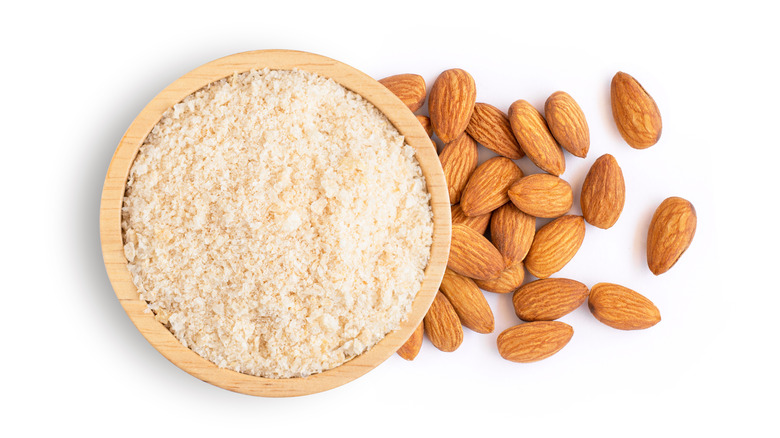The Ultimate Guide To Almond Flour
Where nut-based ingredients are concerned, almond flour is one of the most straightforward. As you might infer from the name, almond flour is a flour-like substance made by grinding blanched almonds (i.e., almonds without skins) into a fine powder. However, it may not be as easy to intuit what you can do with it. Read on to learn how to make the most of this rich, delicious, gluten-free wheat flour alternative.
According to the Harvard T.H. Chan School of Public Health, almond flour is not only gluten-free and low-carb but also has more nutrients than wheat flour. While higher in fat and calories, these are primarily from monounsaturated fats (or healthy fats). Plus, almonds are packed with beneficial fatty acids. Even better, eating tree nuts has been connected to a lowered risk of heart disease. As more and more consumers follow a gluten-free, low-carb, keto, or paleo diet — either by necessity or choice — the increasing demand for almond flour is predicted to continue, according to Persistence Market Research.
While you can buy it off the shelf, making almond flour at home is easy. Grind blanched almonds to the preferred consistency in a food processor, but beware: If you let it go too long, you may end up with something closer to almond butter than almond meal — which is a bit coarser than almond flour and usually made from unblanched almonds, including the skins — or fine almond flour.
How to store and use almond flour
When storing almond flour, keep in mind that almonds have a high fat content and retain moisture, even in flour form. Avoid buying almond flour in bulk unless you plan to go through it quickly, and store it properly in a well-sealed container kept in a cool, dry place. Once opened, your best bet for storage is in the refrigerator or freezer.
Are you curious about how to use almond flour? Go to any supermarket and, along with the bags of almond flour, you'll find a wide range of products made with it, such as cookies, crackers, cereals, baked goods, and even vegan meat alternatives. While you can buy ready-made products at the store, you can also make them at home!
When baking with almond flour, remember that because of its higher moisture content, it's not a perfect 1-to-1 substitute for all-purpose flour in baking. To make the swap, start with ¾ cup of almond flour to 1 cup of regular flour, and be prepared to add more of your binding ingredient to hold everything together. Speaking of limitations, since it is slightly grainy, using almond flour to thicken something like a smooth gravy isn't the best option. Since it's made from ground almonds, it can carry a very subtle almond flavor, which can be advantageous in some scenarios, like baked goods. Or, this aspect can be seamlessly hidden in other applications, like breading on fried foods or a binder in veggie burgers.

